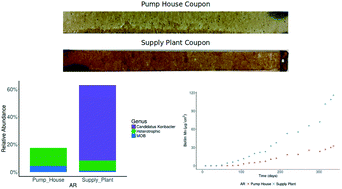Potential for manganese biofouling in water transmission lines using model reactors†
Abstract
Manganese (Mn) in drinking water systems can accumulate in Mn-oxide deposits which can be resuspended and re-released leading to dirty water events. Public health concerns regarding Mn are growing due to recent studies correlating Mn in drinking water with neurotoxicity in children. Understanding the factors impacting biologically mediated Mn deposition within water supply systems is crucial to developing strategies that limit Mn in drinking water. Annular reactors containing coupons for biofilm growth were installed at the beginning (Pump House) and end (Supply Plant) of the raw water transmission pipeline at a water supply plant in Nova Scotia, Canada to investigate Mn biofouling. Water quality parameters, the concentration of Mn in bulk water and biofilm, and Mn oxidizing bacteria (MOB) within biofilms were measured. Biofilm communities were characterized by 16S rRNA sequencing. Dissolved Mn concentrations decreased (∼20%) as water travelled from the pump house to the supply plant. Despite this reduction, culturable MOB and Mn-oxides were 80% and 70% greater, respectively, in the supply plant reactor biofilm relative to the pump house. Surprisingly, sequencing analysis showed the abundance of known MOB was greater in the pump house reactor than the supply plant reactor. The biofilm community in the supply plant reactor was composed mainly (55%) of the genus Candidatus Koribacter. BLASTp analysis of Candidatus koribacter versatilis identified four proteins homologous to multicopper oxidases, which are known to perform Mn oxidation. We suggest Candidatus Koribacter may be a novel MOB which has a considerable impact on biological Mn oxidation and Mn biofouling.



 Please wait while we load your content...
Please wait while we load your content...